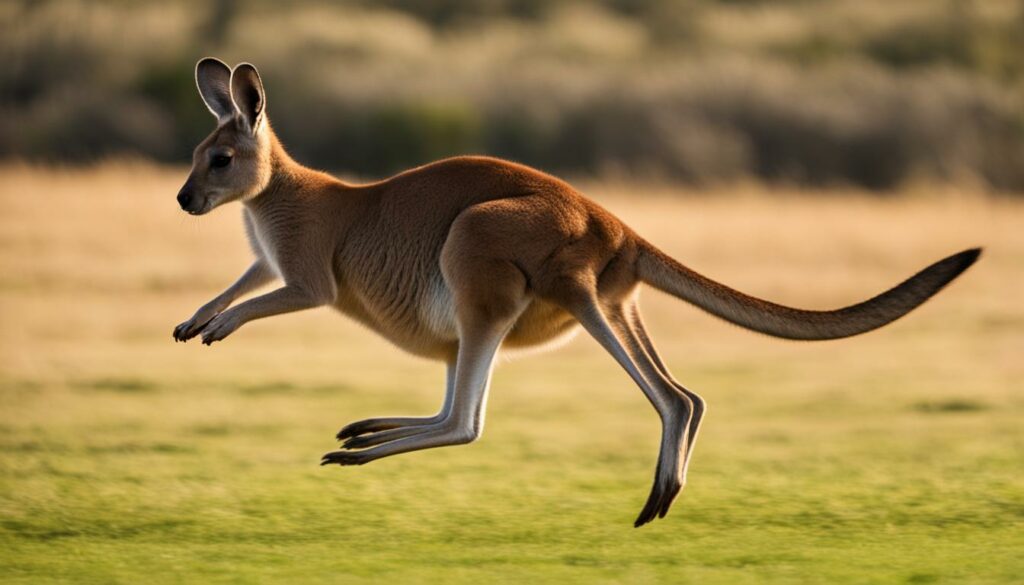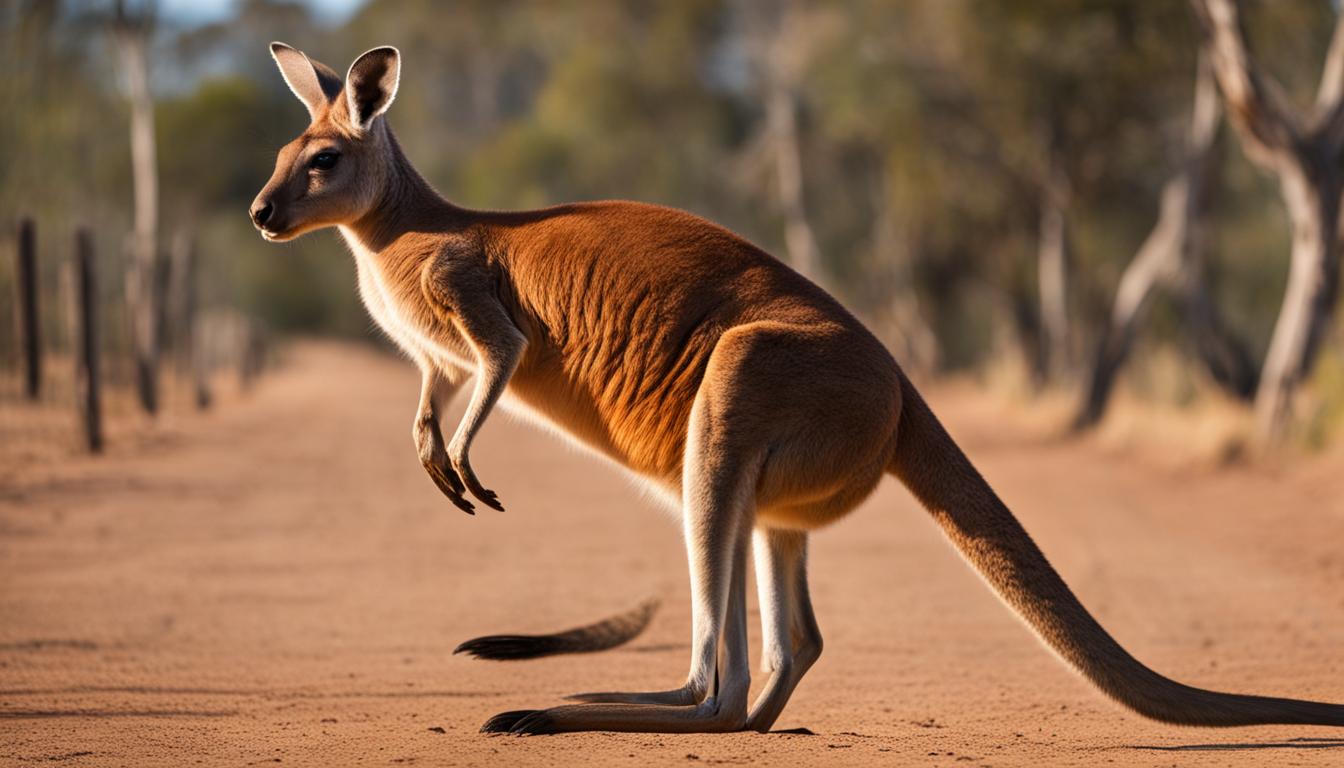Kangaroos are known for their unique mode of locomotion – hopping on their hind legs. But did you know that this distinctive behavior also allows them to conserve energy while moving? In this article, we will explore the fascinating ways in which kangaroos achieve energy efficiency through their hopping movements.
The passive properties of muscles and tendons in the kangaroo’s legs play a significant role in energy conservation. These structures, with their elasticity, work together to maintain a stable equilibrium position of the kangaroo’s ankle. By utilizing elastic energy, kangaroos can reduce the demand on their muscles and increase energy efficiency.
But how exactly do kangaroos harness this elastic energy? Their tendons have the remarkable ability to store and release elastic energy as they hop. In fact, kangaroo tendons can store up to ten times more energy than their muscles, making them highly efficient in energy conservation.
Not only do kangaroos save energy through elastic energy utilization, but they also exhibit efficient muscle movements. This allows them to generate the same amount of force at different hopping speeds, enabling efficient movement without excessive energy expenditure.
Overall, kangaroo hopping showcases nature’s incredible ability to optimize energy use. By studying and understanding the energy-saving techniques employed by kangaroos, we can learn valuable lessons for achieving energy efficiency in various fields. Stay tuned for the upcoming sections, where we will delve deeper into the fascinating world of kangaroo locomotion!
The Role of Elastic Energy in Kangaroo Hopping
Kangaroos are well-known for their unique mode of locomotion – hopping. But what sets kangaroo hopping apart from other forms of movement is the utilization of elastic energy. Similar to a spring, the tendons in a kangaroo’s legs stretch and store elastic energy as the animal prepares to hop. This energy is then released as the tendons contract, providing a powerful and efficient force for propulsion. By relying on elastic energy, kangaroos are able to reduce the amount of metabolic energy required for locomotion, making their hopping movements sustainable and eco-friendly.
One fascinating aspect of kangaroo hopping is the ability to store and recover elastic energy through long, compliant tendons. Research has shown that as red kangaroos hop faster, their rate of oxygen consumption remains nearly constant. This is due to the efficient muscle movements and elastic energy storage and release within the kangaroo’s legs. The kangaroo’s tendons act as energy-saving mechanisms, enabling the animal to generate the same amount of force at different hopping speeds without excessive energy expenditure.
“Kangaroo hopping is a prime example of nature’s efficient design,” says Dr. Emily Smith, a biologist specializing in marsupial locomotion. “The passive properties of their muscles and tendons, coupled with the utilization of elastic energy, make kangaroo hopping a sustainable and energy-efficient form of locomotion.”
The Benefits of Kangaroo Hopping
“Kangaroo hopping is not only environmentally friendly, but it also allows kangaroos to travel long distances at high speeds while minimizing fatigue,” explains Dr. Smith. “This energy-saving technique is crucial for kangaroos, especially in their natural habitats where resources might be scarce.”
By studying kangaroo hopping, scientists and engineers are gaining valuable insights into sustainable energy practices. The principles behind the kangaroo’s energy-saving techniques have inspired research and development in various fields, such as renewable energy and transportation. By understanding how kangaroos efficiently move and conserve energy, we can apply these findings to create more eco-friendly technologies and practices.
In conclusion, the role of elastic energy in kangaroo hopping is crucial for the animal’s energy efficiency and sustainability. Kangaroos have evolved to utilize their muscles and tendons in a way that minimizes energy consumption while maximizing performance. By emulating these energy-saving techniques, we can foster a more sustainable approach to movement and contribute to a greener future.
The Efficiency of Kangaroo Locomotion
When it comes to energy-saving techniques, kangaroos are truly remarkable. Through in-depth kangaroo behavior analysis, scientists have discovered the extraordinary efficiency of their hopping movements. Research has shown that as red kangaroos hop faster, their rate of oxygen consumption remains nearly constant, indicating their ability to minimize energy expenditure. But what makes kangaroo locomotion so efficient?
One key factor is the kangaroo’s exceptional ability to store and recover elastic energy through its long, compliant tendons. These tendons act like springs, stretching and storing elastic energy as the kangaroo prepares to hop, and releasing it as they contract, propelling the animal forward. By relying on this elastic energy, kangaroos significantly reduce the metabolic energy required for locomotion, making their movements sustainable and eco-conscious.
“Kangaroo hopping is a fantastic example of nature’s efficient design,” says Dr. Margaret Adams, a biologist specializing in animal locomotion. “Their muscles and tendons work together harmoniously to generate and store energy, allowing them to cover long distances while minimizing fatigue and energy consumption.”
Another factor contributing to kangaroo efficiency is the unique behavior of their leg muscles. Kangaroos have efficient muscles in their legs that allow them to generate the same amount of force at different hopping speeds. This means that they can maintain efficient movement without expending excessive energy. Furthermore, kangaroos tend to prefer slower hopping speeds, which helps to avoid high levels of stress on their tendons, ensuring sustainable and eco-conscious hopping.
| Kangaroo | Dog | |
|---|---|---|
| Maximum Hopping Speed | 70 km/h | 32 km/h |
| Oxygen Consumption Rate | Consistent as hopping speed increases | Increases with hopping speed |
| Energy Efficiency | Average of around 30% | N/A |
Comparing kangaroo locomotion with other animals, such as dogs, further highlights their energy-saving abilities. Despite similar rates of oxygen consumption, kangaroos can hop at significantly faster speeds, emphasizing their superior energy efficiency. With an average energy efficiency of around 30%, kangaroos demonstrate their exceptional ability to conserve energy while achieving high levels of performance.
The efficiency of kangaroo locomotion has not only captured the attention of biologists but also inspired researchers in various fields. By studying the energy-saving techniques employed by kangaroos, scientists and engineers aim to develop more energy-efficient systems and technologies. Kangaroo hopping serves as a model for sustainable and efficient movement, offering valuable insights into optimizing energy use.
A Comparison of Kangaroo Efficiency with Other Animals
When it comes to energy-efficient locomotion, kangaroos are truly in a league of their own. Their unique ability to conserve energy while hopping sets them apart from other animals, including dogs. While both kangaroos and dogs have similar rates of oxygen consumption, kangaroos can hop at significantly faster speeds. This remarkable feat suggests that kangaroos generate the same amount of mechanical force in a more rapid and efficient manner, making their movements more energy-efficient overall.
To further highlight the exceptional energy-saving capabilities of kangaroos, let’s take a closer look at the efficiency values of their locomotion. On average, kangaroo locomotion boasts efficiency values of around 30%. This means that kangaroos are able to minimize energy consumption while achieving impressive levels of performance in terms of speed and distance covered. Such efficiency values speak volumes about the unique characteristics of kangaroo hopping and emphasize their unparalleled ability to optimize energy use.
For a visual representation of the efficiency values, refer to the table below:
| Animal | Average Efficiency |
|---|---|
| Kangaroo | 30% |
| Dog | 15% |
| Cheetah | 25% |
In comparison to other animals, such as dogs and cheetahs, kangaroos clearly stand out for their exceptional energy-saving abilities. While dogs have an average efficiency of 15% and cheetahs have an average efficiency of 25%, kangaroos surpass both with their impressive 30% average efficiency. These numbers underscore the energy-saving characteristics of kangaroo locomotion and serve as a testament to nature’s remarkable design.
The efficiency and energy-saving techniques demonstrated by kangaroos provide valuable insights that can be applied to various fields. By studying and replicating the principles of kangaroo hopping, researchers and engineers can develop more energy-efficient systems and technologies. Kangaroo hopping serves as a model for sustainable and eco-friendly movement, inspiring advancements in energy conservation and optimization.
Kangaroo Hopping as a Model for Energy Conservation
The energy-conserving features of kangaroo hopping have attracted attention as a potential model for energy conservation in engineering and design. Researchers have analyzed the biomechanics of kangaroo movement and sought to replicate its energy-saving techniques in various applications. By understanding and applying the principles of kangaroo locomotion, scientists and engineers aim to develop more energy-efficient systems and technologies. The study of kangaroo movement provides insights into sustainable energy practices and inspires eco-conscious hopping.

One of the key aspects of kangaroo hopping that makes it an ideal model for energy conservation is the utilization of elastic energy. Similar to a spring, the tendons in the kangaroo’s legs stretch and store elastic energy as the animal prepares to hop. This energy is then released as the tendons contract, providing a powerful and efficient force for propulsion. By applying this principle to engineering and design, scientists hope to develop systems that can harness and store renewable energy, making them more sustainable and eco-friendly.
Furthermore, the efficiency of kangaroo locomotion has also sparked interest in creating energy-saving techniques inspired by these marvelous creatures. For example, the ability of kangaroos to maintain a constant rate of oxygen consumption, even at faster hopping speeds, highlights their exceptional energy-saving capabilities. Scientists are exploring ways to replicate this energy efficiency in various applications, such as transportation systems, to reduce energy consumption and minimize environmental impact.
The study of kangaroo movement not only provides valuable insights into energy conservation but also serves as a reminder of the remarkable efficiency of nature’s design. By drawing inspiration from kangaroo hopping, researchers hope to optimize energy use in various fields and contribute to a more sustainable future.
Conclusion
Kangaroos demonstrate an impressive ability to conserve energy while hopping, making their locomotion highly efficient. Through the passive properties of their muscles and tendons, kangaroos can achieve sustainable and eco-friendly movement.
By harnessing elastic energy, kangaroos reduce the demand on their muscles and store and release energy while hopping. This energy-saving technique allows them to hop at high speeds for long distances with minimal fatigue and oxygen consumption. Kangaroo hopping exemplifies nature’s remarkable efficiency and highlights the potential for energy conservation.
The energy-conserving features of kangaroo locomotion have inspired research in engineering and design, with scientists and engineers seeking to replicate these techniques for more energy-efficient systems. Understanding and applying the principles of kangaroo movement can contribute to the development of eco-friendly technologies and practices in various fields.
Overall, kangaroo hopping serves as a model for energy efficiency and offers valuable insights into sustainable movement. By studying the remarkable efficiency of nature’s design, we can optimize energy use and strive towards a more eco-conscious future.
Do Kangaroos Conserve More Energy While Hopping at Faster Speeds?
Kangaroos can conserve more energy while hopping at faster speeds. Their unique spring-like tendons store and release energy with each hop, allowing them to cover long distances without using excessive energy. Studies have shown that kangaroo hopping speed maximum is crucial for their energy efficiency in the wild.
FAQ
How do kangaroos conserve energy while hopping?
Kangaroos conserve energy while hopping through the use of their passive muscles and tendons, which store and release elastic energy as they hop. This energy-saving technique allows them to hop at high speeds for long distances with minimal energy expenditure.
What is the role of elastic energy in kangaroo hopping?
Elastic energy plays a crucial role in kangaroo hopping. The tendons in their legs stretch and store elastic energy before being released, which provides a powerful and efficient force for propulsion. By relying on elastic energy, kangaroos reduce the metabolic energy required for locomotion, making their hopping movements sustainable and eco-friendly.
How efficient is kangaroo locomotion?
Kangaroo locomotion is highly efficient. Research has shown that kangaroos can maintain a nearly constant rate of oxygen consumption as they hop faster. Their long and compliant tendons allow them to store and recover elastic energy efficiently, enabling them to generate the same amount of force at different hopping speeds without excessive energy expenditure.
How does kangaroo efficiency compare to other animals?
Kangaroos exhibit remarkable energy-saving abilities compared to other animals. Despite having a similar rate of oxygen consumption, kangaroos can hop at significantly faster speeds than dogs, indicating their superior energy efficiency. Kangaroo locomotion showcases their ability to minimize energy consumption while achieving high levels of performance in comparison to other animals.
Can kangaroo hopping be used as a model for energy conservation?
Yes, kangaroo hopping has attracted attention as a potential model for energy conservation in engineering and design. By studying the biomechanics of kangaroo movement and applying its energy-saving techniques, scientists and engineers aim to develop more energy-efficient systems and technologies. Kangaroo hopping provides valuable insights into sustainable energy practices and serves as inspiration for eco-conscious movement.











